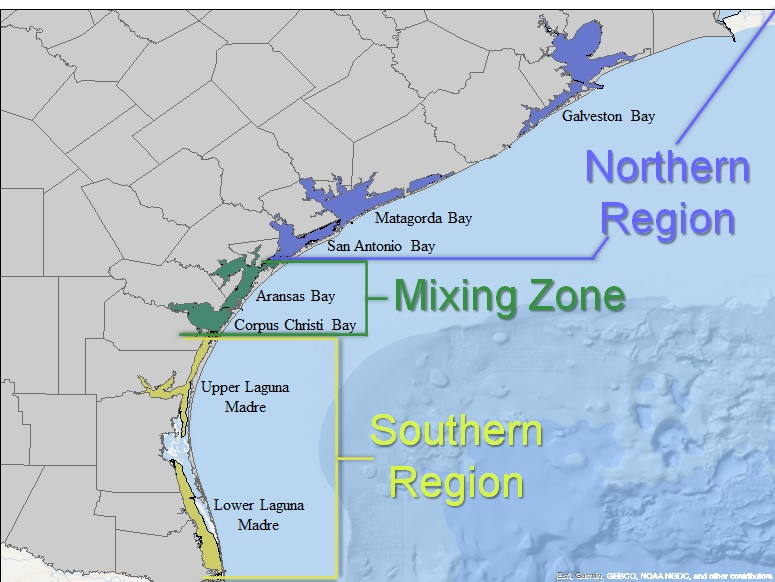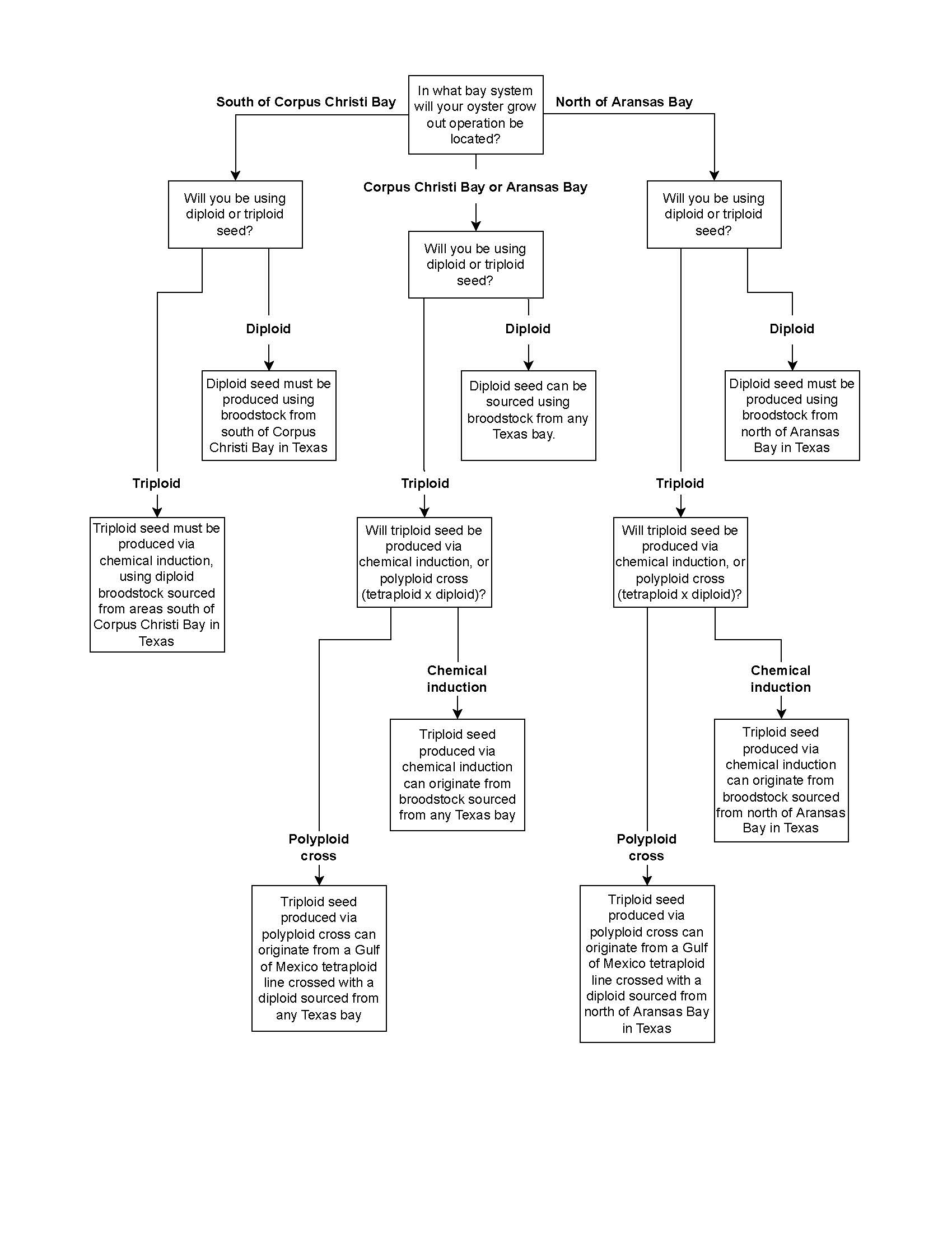Hatchery and Seed Importation Requirements
Cultivated oysters share habitat with Texas’s native oyster species. Thus, there are strict rules in place to protect the health of both wild and farmed oysters and avoid introducing non-native species into the ecosystem. Ideally, Texas oyster growers should purchase seed from Texas hatcheries; however, at times, purchasing seed, larvae, or broodstock from out-of-state hatcheries may be necessary. In these cases, TPWD has instituted strict rules for importing and transferring out-of-state oysters at any stage in their life cycle.
Out-of-State Hatchery Requirements/Nursery Requirements
Out-of-state hatcheries and nurseries can only be used if they meet the following requirements
-
Products must be certified as disease free (with test results from a TPWD-approved laboratory) and of the proper genetic regional origin.
-
Hatcheries and nurseries must work exclusively with Gulf oysters (cannot accept oysters from the Atlantic or Pacific coasts).
-
Hatcheries and nurseries cannot allow oysters, seed, or larvae bound for Texas to have contact with water from organisms from the Atlantic or Pacific coasts.
-
Hatchery and nursery have been vetted by TPWD for their biosecurity procedures. Before placing an order check with the TPWD Cultivated Oyster Mariculture Program coordinator that the location has been approved.
Each time seed is imported from an out-of-state hatchery/nursery, the importer must first provide signed copies of the Oyster Chain of Custody Form and disease testing results to TPWD. The importer must submit an Oyster Transfer Request Form to TPWD and receive authorization writing before seed, larvae, or broodstock are imported into Texas.
Moving Oyster or Seed Between Sites
Regardless of where the oysters or seed come from, they cannot be stocked or moved between permitted sites (including farms, hatcheries, and nurseries) without first submitting an Oyster Transport Request to TPWD at least seven (7) days in advance of planned transport and receiving authorization back from TPWD. The only time the form is not required is when transporting harvested and tagged oysters to a certified location for sale.

A map of the south-east coast of Texas indicating different regions. The Northern Region includes Galveston Bay, Matagorda Bay, and San Antonio Bay. The Southern Region includes Upper Laguna Madre and Lower Laguna Madre. The Mixing Zone spans between the Northern and Southern regions, incluing Aransas Bay and Corpus Christi Bay.
Genetic Regions for Texas Oysters
Texas has two distinct genetic populations of Eastern oysters that overlap in a mixing zone between the Corpus Christi/Aransas Bay areas. To protect these genetic populations, growers must take care to only use seed produced by broodstock from the appropriate region. The seed selected depends on the site of the farm in relation to genetic regions (Table 1).

Flowchart illustrating the following process:
Step 1. In what bay system will your oyster grow out operation be located?
- If South of Corpus Christi Bay, go to Step 2.1
- If Corpus Christi Bay or Aransas Bay, go to Step 2.2
- If North of Aransas Bay, got to Step 2.3
Step 2.1. Will you be using diploid or triploid seed?
- If Triploid, go to step 3.1.1.
- If Diploid, go to step 3.1.2.
Step 2.2. Will you be using diploid or triploid seed?
- If Triploid, go to step 3.2.1.
- If Diploid, go to step 3.2.2.
Step 2.3. Will you be using diploid or triploid seed?
- If Triploid, go to step 3.3.1.
- If Diploid, go to step 3.3.2.
Step 3.1.1. Triploid seed must be produced via chemical induction, using diploid broodstock sourced from areas south of Corpus Christi Bay in Texas
- Stop
Step 3.1.2. Diploid seed must be produced using broodstock from south of Corpus Christi Bay in Texas
- Stop
Step 3.2.1. Will triploid seed be produced via chemical induction, or polyploid cross (tetraploid x diploid)?
- If Polyploid cross, go to step 4.1.1
- If Chemical Induction, go to step 4.1.2
Step 3.2.2. Diploid seed can be sourced using broodstock from any Texas bay.
- Stop
Step 3.3.1. Will triploid seed be produced via chemical induction, or polyploid cross (tetraploid x diploid)?
- If Polyploid cross, go to step 4.2.1
- If Chemical Induction, go to step 4.2.2
Step 3.2.2. Diploid seed must be produced using broodstock from north of Aransas Bay in Texas
- Stop
Step 4.1.1. Triploid seed produced via polyploid cross can originate from a Gulf of Mexico tetraploid line crossed with a diploid sourced from any Texas bay
- Stop
Step 4.1.2. Triploid seed produced via chemical induction can originate from broodstock sourced from any Texas bay
- Stop
Step 4.2.1. Triploid seed produced via polyploid cross can originate from a Gulf of Mexico tetraploid line crossed with a diploid sourced from north of Aransas Bay in Texas
- Stop
Step 4.2.2. Triploid seed produced via chemical induction can originate from broodstock sourced from north of Aransas Bay in Texas
- Stop
Importing Diploid, Triploid, and Tetraploid Oysters into Texas
Farmers must not only consider the genetic origin of oyster seed, but also the number of chromosomes — or ploidy — in their oyster stock. Wild oysters are diploid, meaning the egg and sperm cells contain two sets of chromosomes (2N). However, triploid (three sets of chromosomes; 3N) oysters are often preferred for commercial farming because they grow larger and plumper than diploid oysters and perform better during the hot summer months. Triploid oysters are usually sterile, so they cannot breed with commercial or wild stock. To get triploid oyster seed, it is common to cross a diploid with a tetraploid (oysters with four sets of chromosomes; 4N).
See Oyster 101 for more information on ploidy.
Seed Stocking and Importation Requirements
To stock seed oysters the state of Texas, the following documentation is required:
-
TPWD Oyster Transport Request Form (TPWD form PWD1439F), including:
-
Name and address of applicant (recipient; nursery or grow-out permit number)
-
Name and address of source facility (e.g., out-of-state hatchery/nursery)
-
Life stage (e.g., larvae, seed) and size (mm) of oysters to be imported
-
Quantity of each
-
The seed destination (stocking site)
-
Ploidy information
-
Geographic origin of all broodstock
-
-
Disease testing results (Oyster Health Certificate)
-
Required for all oysters coming from Out-of-State
-
May be required for oysters’ movement within Texas, contact a TPWD COM official
-
| Farm Location | Acceptable Triploid Genetic Origins |
|---|---|
| North of Aransas Bay to Louisiana state line | Cross between established Gulf of Mexico tetraploid broodstock line and diploids from northern Texas estuaries OR Cross between northern Texas estuary broodstock diploids that have been chemically induced into triploids |
| South of Corpus Christi Bay to Lower Laguna Madre | Triploid seed must be produced via chemical induction using broodstock entirely from southern Texas estuaries. |
| Corpus Christi or Aransas Bay System | Cross between an established Gulf of Mexico tetraploid broodstock line and a diploid from any Texas estuary OR Cross between any Texas estuary broodstock diploids that have been chemically induced into triploids |
Texas Oyster Seed Disease testing Requirements
To avoid introducing diseases into the wild and captive oyster populations, all oysters imported into Texas from other states must be tested for the following pathogens:
-
MSX (Haplosporidium nelsoni)
-
Dermo (Perkinsus marinus)
-
Bonamiosis (Bonamia exitiosa)
-
Oyster Herpes Virus (OsHV-1)
Each batch (same seed lot, same producer, and held in the same environment) of oyster seed, larvae, or broodstock brought into Texas must undergo two types of disease testing by a TPWD-approved laboratory):
-
Microscopic (histological) testing
-
A representative sample (n = 60) of the seed, larvae, or broodstock to be imported must be processed to produce microscope slides showing all major tissue types.
-
Slides must be read by an invertebrate pathologist.
-
All evidence of disease (MSX, Dermo, Bonamiosis and others) found within the tissue must be reported.
-
-
Specialized testing for Dermo
-
A representative sample (n = 60) of seed, larvae, or broodstock to be imported into Texas must be tested for the presence of Perkinsus marinus (Dermo) using Rays Fluid Thioglycolate Media (RTFM), PCR, or qPCR techniques
-
Oyster Health Certificate
Anyone planning to import oysters into Texas must first submit an Oyster Health Certificate to TPWD. The Oyster Health Certificate should include the following:
-
Dated and detailed pathology report, including the results for each pathology test and a description of the methods used
-
Name of the hatchery/nursery from which the seed originated
-
Certification case number
-
Certification date
To qualify for approval, oyster seed, larvae, or broodstock can have a maximum prevalence of 10% for Dermo and zero for all other parasites or disease. Oyster Health Certificates are valid for 60 days after testing.
